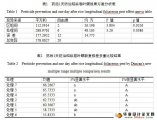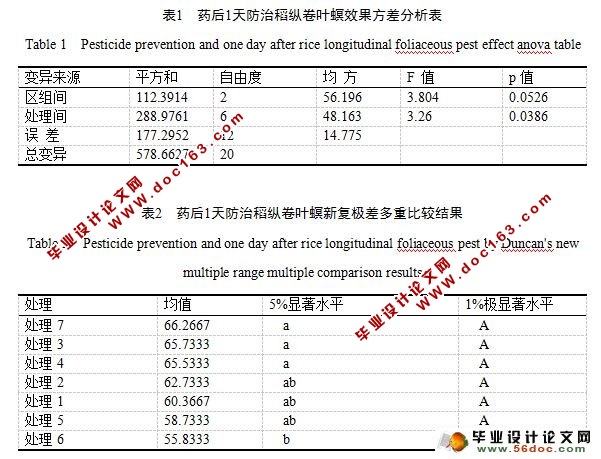20%氟虫双酰胺对稻纵卷叶螟的防效研究

资料介绍:
20%氟虫双酰胺对稻纵卷叶螟的防效研究(毕业论文9040字)
[资料来源:http://www.doc163.com]
摘 要:稻纵卷叶螟属迁飞性害虫,是危害我国水稻的主要虫害之一,以幼虫为害水稻叶片为主。结合湖北地区水稻生产特点,分析稻纵卷叶螟大发生特点和预测方法,提出20%氟虫双酰胺各种配比药剂对稻纵卷叶螟的防治方法。本题通过大田小区试验20%氟虫双酰胺水分散粒剂与甲维盐水分散粒剂混配对稻纵卷叶螟的防效研究,对将来推广此药剂具有重要意义,为指导生产防治稻纵卷叶螟和开发复配杀虫剂提供理论依据。试验设8个处理,3次重复,共24个小区,采用随机区组排列,处理前调查幼虫基数,处理后1、3、7天调查幼虫残存活虫数,处理14天调查卷叶数。采用DPS7.05进行数据分析,研究证明20%氟虫双酰胺与5%甲维盐混配是防治稻纵卷叶螟较好配方。
关键词:稻纵卷叶螟;20%氟虫双酰胺;水稻;防效研究
Control effect of 20% flubendiamide on Cnaphalocrocis medinalis
Abstract:Cnaphalocrocis medinalis had moved fly pests, is the main insect prejudicial to China's rice, one of mainly with rice leaves larvae harm. Combined with hubei area rice production characteristic, analysis of Cnaphalocrocis medinalis occurrence characteristics and pest big forecast method, puts forward 20% flubendiamide various ratio of Cnaphalocrocis medinalis dispensarization.Ontology through field plot test 20% flubendiamide water dispersible granule agent and Emamectin benzoate scattered grain agent mix pairing of Cnaphalocrocis medinalis control effect on future research, promotion this elixir is important, for guiding the production control Cnaphalocrocis medinalis and development of longitudinal provide theoretical basis for complex match pesticides. Test set 8 processing, 3 times repeat, a total of 24 village, using randomized to arrange, handling, processing base of former survey larvae after 1, 3, 7 days remaining live insect larvae number investigation, deal with 14 days survey foliaceous number. Using DPS7.05 data analysis, research proof 20% flubendiamide and 5% Emamectin benzoate mixed is prevention Cnaphalocrocis medinalis better formula.
Key words:leaf roller; 20% fluorine insect double amide; rice; control effect

目 录
摘 要 1
关键词 1
1 前言 2
1.1 20%氟虫双酰胺对稻纵卷叶螟的研究意义 2
1.2 稻纵卷叶螟研究现状及防治 2
1.3 20%氟虫双酰胺研究现状 4
2 材料与方法 5
2.1 试验材料 5
2.1.1 栽培品种 5
2.1.2 试验对象 5
2.1.3 试验地基本情况 5
2.1.4 供试药剂 5
2.2 试验方法与设计 5
2.2.1 处理方法 5
2.2.2 小区安排 6
2.2.3 施药器械和方法 6
2.2.4 施药时间和次数 6
2.2.5 气象资料 6
2.2.6 调查方法 6
2.2.7 数据处理方法 6
2.2.8 计算方法 7
3 结果与分析 7
4. 结论与讨论 10
参考文献 12
致 谢 13
